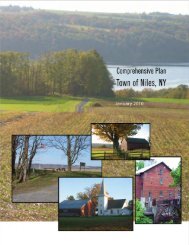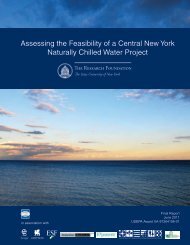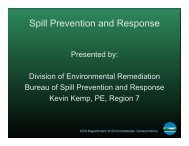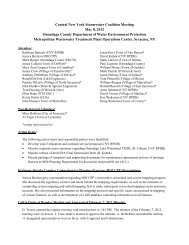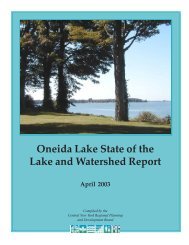A Management Strategy for Oneida Lake and its ... - CNY RPDB Home
A Management Strategy for Oneida Lake and its ... - CNY RPDB Home
A Management Strategy for Oneida Lake and its ... - CNY RPDB Home
Create successful ePaper yourself
Turn your PDF publications into a flip-book with our unique Google optimized e-Paper software.
The Atlantic Salmon Fish Creek Club, Inc.<br />
(ASFCC), a non-profit organization that was<br />
<strong>for</strong>med <strong>for</strong> the enhancement <strong>and</strong> protection of<br />
salmonides species native to New York State,<br />
participates in many activities such as stocking<br />
Atlantic salmon fry in tributaries, electroshocking<br />
streams to determine population, <strong>and</strong><br />
taking measurements to document stream<br />
ecology. Native Atlantic salmon populations<br />
in the <strong>Oneida</strong> <strong>Lake</strong> watershed were likely<br />
eliminated due to the construction of dams<br />
<strong>and</strong> the introduction of alewives in the <strong>Lake</strong><br />
Ontario system. Additional in<strong>for</strong>mation about<br />
the ASFCC can be found on their website<br />
http://www.dreamscape.com/flyman, or by<br />
calling toll-free (888) 531-5080.<br />
(Source: www.metsa.fi/hiking/boating/fishing.htm)<br />
species to waters they <strong>for</strong>merly occupied. Fish<br />
distribution in the <strong>Oneida</strong> <strong>Lake</strong> watershed<br />
(number <strong>and</strong> species) is available on the<br />
Internet at www.dec.state.ny.us/website/<br />
dfwmr/ fish/foe4clst.html.<br />
The <strong>Oneida</strong> Fish Cultural Station located on<br />
Scriba Creek in the Town of Constantia has a<br />
goal of stocking 150 million newly hatched<br />
walleye fry each year in <strong>Oneida</strong> <strong>Lake</strong>. This<br />
number is sometimes exceeded depending on<br />
the success of the egg take. For example,<br />
2001 was a successful year <strong>and</strong> 160 million<br />
fry were released. Almost 200,000 summer<br />
fingerlings were also stocked in 2001 <strong>and</strong><br />
100,000 walleye that over wintered in the<br />
hatchery were stocked in 2002.<br />
The Cornell Biological Field Station has a<br />
long history of research on the fish <strong>and</strong> fishery<br />
of <strong>Oneida</strong> <strong>Lake</strong>. There are over 200 publications<br />
in the scientific literature associated with<br />
this lake since the 1950s. The table found on<br />
the previous page provides a summary of the<br />
current projects at the Cornell Biological Field<br />
Station.<br />
Studies by Cornell University <strong>and</strong> the NYS<br />
DEC led to criteria established in 1978 that<br />
have been the basis <strong>for</strong> the management of<br />
<strong>Oneida</strong> <strong>Lake</strong>’s walleye fishery. The goal of<br />
walleye management in <strong>Oneida</strong> <strong>Lake</strong> is to<br />
optimize recreational fishing opportunities <strong>for</strong><br />
both walleye <strong>and</strong> yellow perch by maintaining<br />
the walleye population at levels that have<br />
proven to produce acceptable perch recruitment<br />
in the past. Too low of a walleye<br />
population is detrimental to the fishery <strong>and</strong><br />
can lead to overabundance of slow growing<br />
yellow perch. Conversely, too many walleyes<br />
may restrict perch recruitment. Bag lim<strong>its</strong> <strong>and</strong><br />
length lim<strong>its</strong> <strong>for</strong> other <strong>Oneida</strong> <strong>Lake</strong> fish<br />
species follow the statewide regulations. The<br />
statewide regulation <strong>for</strong> walleye is five fish of<br />
15 inches or larger per day per angler.<br />
Chapter 3: Priority Areas page 67



